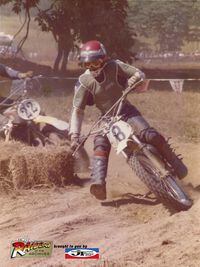Gary believes this photo was taken in 1974 at Lexington (Mid-Ohio) of him racing his open class, factory Husqvarna. The photo was taken by Gary's mom, on his hometown track where he grew up racing as an amateur and later raced as a pro. Gary finished the 1974 season in fourth place in the 500cc championship.
THE EVENT: "It was one of the tracks on the tour both for the National and the Trans Am races. It was a pretty good track. It was kind of hardpacked dirt, it wasn't very soft or sandy, it was mostly clay. The layout for those times was pretty good. The start was wide, long, and fast and was all by itself. The whole start and first corner were separate and then finally went onto the track, so it had a nice infield area for the start. As I remember it was one of the first tracks that had a double jump in it. The way it was built, it was pretty fast and it was a small take off and a small landing that you had to clear, but there weren't too many people doing it. It was pretty fast and in those times on those old bikes, to hit something that hard and jump that far, to where you had to clear the landing or you were going to endo... If you would have come up short, it was probably a 99% chance of you doing a big yard sale on it. Because the suspension wasn't forgiving at all and to make a mistake like that you'd get kicked off pretty hard... I definitely considered this a home track. It was only about a two hour drive from my house and I started out racing a lot of local races at that track... I didn't really feel that I had an advantage, it just felt good to be so close to home and have a lot of friends there that I knew would be rooting for me. But I felt that anywhere on the eastern side of the US I had an advantage, because it was so different than my main competitions' tracks and what they were used to. At that time most of the best riders were from California, and it was a big adjustment for me the first time to go to California and race on those hardpack clay tracks. The soil conditions were so hard compared to what we were used to back here."
THE BIKE: "That was a works Husky, and that was before the AMA production rule came into effect so we were still allowed to ride full-on works bikes and all the factory riders had them. They were not made into production, they were all hand-built, one-off machines, and they only made a handful of them. And that Husky was awesome. Every part on it was made form the best material they could make it out of. The bike was light weight, and legendary engine tuner, still today Eric Crippa, was my mechanic. That engine was awesome for that time... Most of the US riders got the works bikes that the Europeans developed, they shared those with us, because at that time European riders had more experience in testing and helping the factories to develop the bikes; so the Americans got what they had developed. I believe that bike was right around a 360 or 380cc displacement, which most of the bikes where at that time. They didn't bump up to 500cc until about the early 80s. Back in the mid-70s they were still usually right around 400cc... When I got that bike I just loved it right off the bat. We already had some pretty good works Huskys before that, but they just kept making them better, and that thing was awesome."
TODAY: "I retired from racing for a living, 1984 was my last year. I still love to ride, and I started doing motocross schools in 1985. Along the way I started to produce motocross technique videos. I did my first one in 1991 and I'm still doing that today. I'm still teaching some motocross schools and I've gotten more into the motocross technique DVD production. I love to help riders get better and spread what I have learned. I'm just having a blast riding still and helping other riders." For more information, more riding tips, and free motocross technique DVD previews, go to www.garysemics.com.

/cloudfront-us-east-1.images.arcpublishing.com/octane/NCYHFQ2S3BAT7EC7VDN2ONGRTU.jpg)
/cloudfront-us-east-1.images.arcpublishing.com/octane/XQORS527YFFT3MVI326EOEYJUI.jpg)
/cloudfront-us-east-1.images.arcpublishing.com/octane/TVDPP3TGMZHODFXASIFUM2KD34.jpg)
/cloudfront-us-east-1.images.arcpublishing.com/octane/EWDMR3DDTBBQPI7DQVZCLMRFAE.jpg)
/cloudfront-us-east-1.images.arcpublishing.com/octane/4XHHLVOUKFE3PDSWNSV4JJMGOE.jpg)
/cloudfront-us-east-1.images.arcpublishing.com/octane/5RLI3NQKQJA3LKKCQHRXQFTL6Q.jpg)
/cloudfront-us-east-1.images.arcpublishing.com/octane/3QCYJCI2RNBENIRWAKEOEKHFUM.jpg)
/cloudfront-us-east-1.images.arcpublishing.com/octane/UZHF7KAE7BFN7KU734ER7PPP3Q.jpg)
/cloudfront-us-east-1.images.arcpublishing.com/octane/XJFFFMRN6VEZ7CDNAGKWVPC3H4.jpg)
/cloudfront-us-east-1.images.arcpublishing.com/octane/RMC3CHWSHFAUJA2WJ2FVG4NBOA.jpg)
/cloudfront-us-east-1.images.arcpublishing.com/octane/WXEZV4WAYBERFKSRE5M7GQBW7A.jpg)
/cloudfront-us-east-1.images.arcpublishing.com/octane/LO3PZVGICFGJZBNUA2ORUSAUSE.jpg)
/cloudfront-us-east-1.images.arcpublishing.com/octane/UFHLTNOXLVARVLZV32M6ZJZV4Y.jpg)
/cloudfront-us-east-1.images.arcpublishing.com/octane/CTSWNU7SNNCC3LWB2KATYZ5AXY.jpg)
/cloudfront-us-east-1.images.arcpublishing.com/octane/IBNGAQWHJJF4TKSIQT54MTWRYQ.jpg)
/cloudfront-us-east-1.images.arcpublishing.com/octane/EAEWHFARGVGHFH4N4BDOSNBJSU.jpg)
/cloudfront-us-east-1.images.arcpublishing.com/octane/AZ7H35TQSZDKZCVM4S6CHERQEU.jpg)
/cloudfront-us-east-1.images.arcpublishing.com/octane/GYMIU7SMN5CWHP6QLFR6MVKEBU.jpg)
/cloudfront-us-east-1.images.arcpublishing.com/octane/B3CX7C4BFFCKBLDWHPQFACBH2E.jpg)
/cloudfront-us-east-1.images.arcpublishing.com/octane/6EIBG7NN4BH4FKDBCPCTLQL6FU.jpg)
/cloudfront-us-east-1.images.arcpublishing.com/octane/3RBI4ZG5NNBCTEUK7MWMKVZ5BE.jpg)
/cloudfront-us-east-1.images.arcpublishing.com/octane/3QKLYI2BWVAMRNNFC5KCGUYRAU.jpg)
/cloudfront-us-east-1.images.arcpublishing.com/octane/B7ITEVP2MRGLXM37KQURRKCG3E.jpg)
/cloudfront-us-east-1.images.arcpublishing.com/octane/BMDGOMSLGFF7XDLBL5DVCTON6Y.jpg)